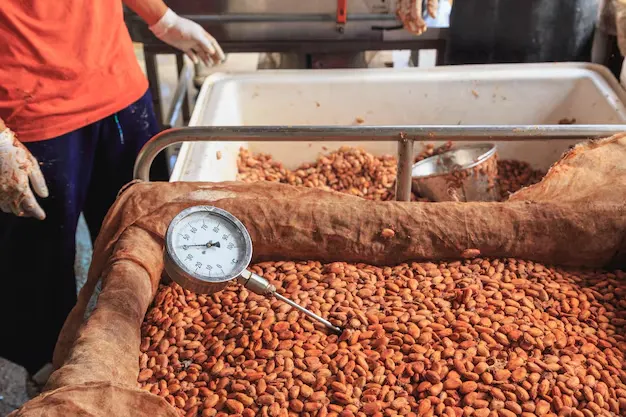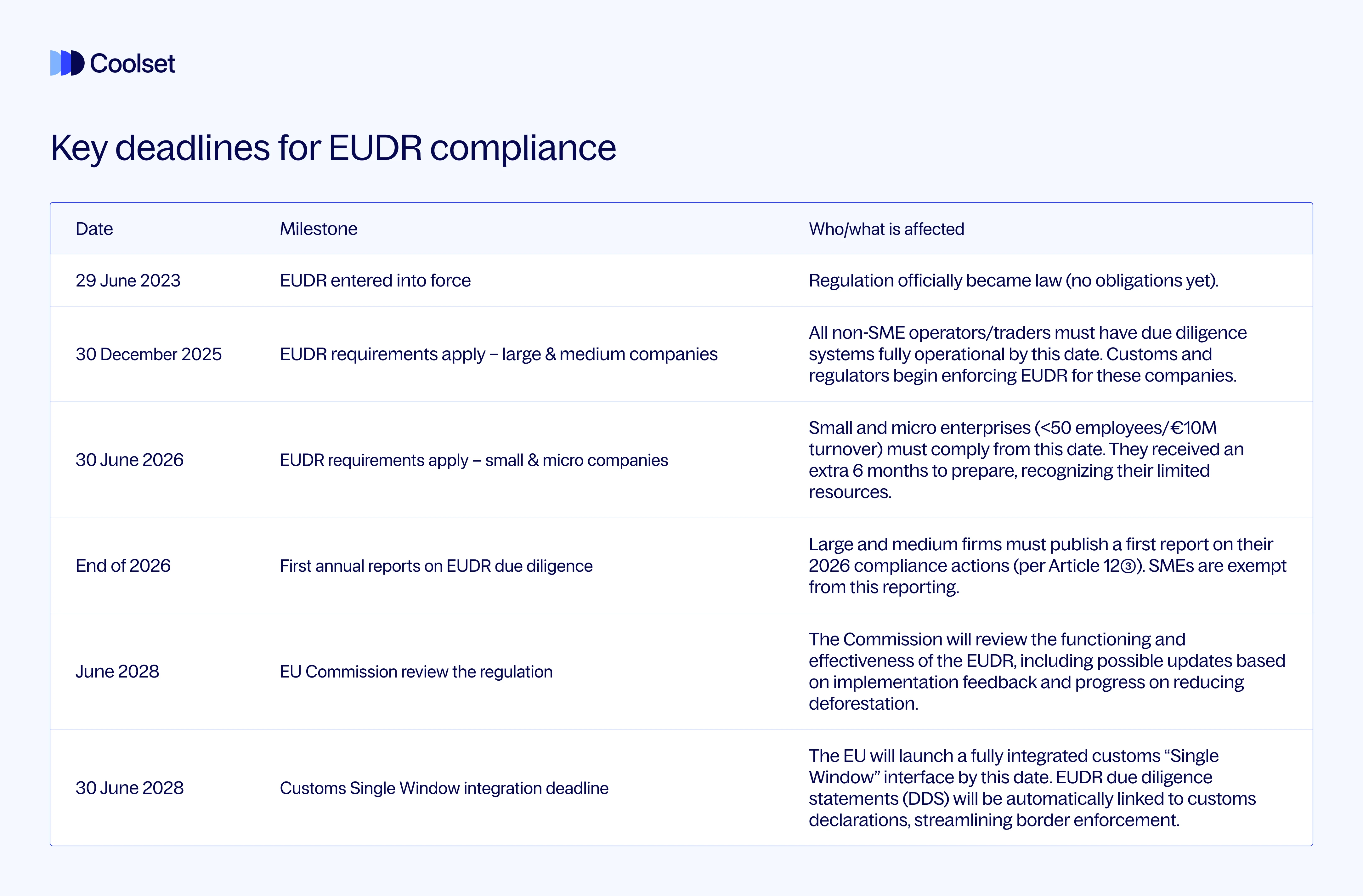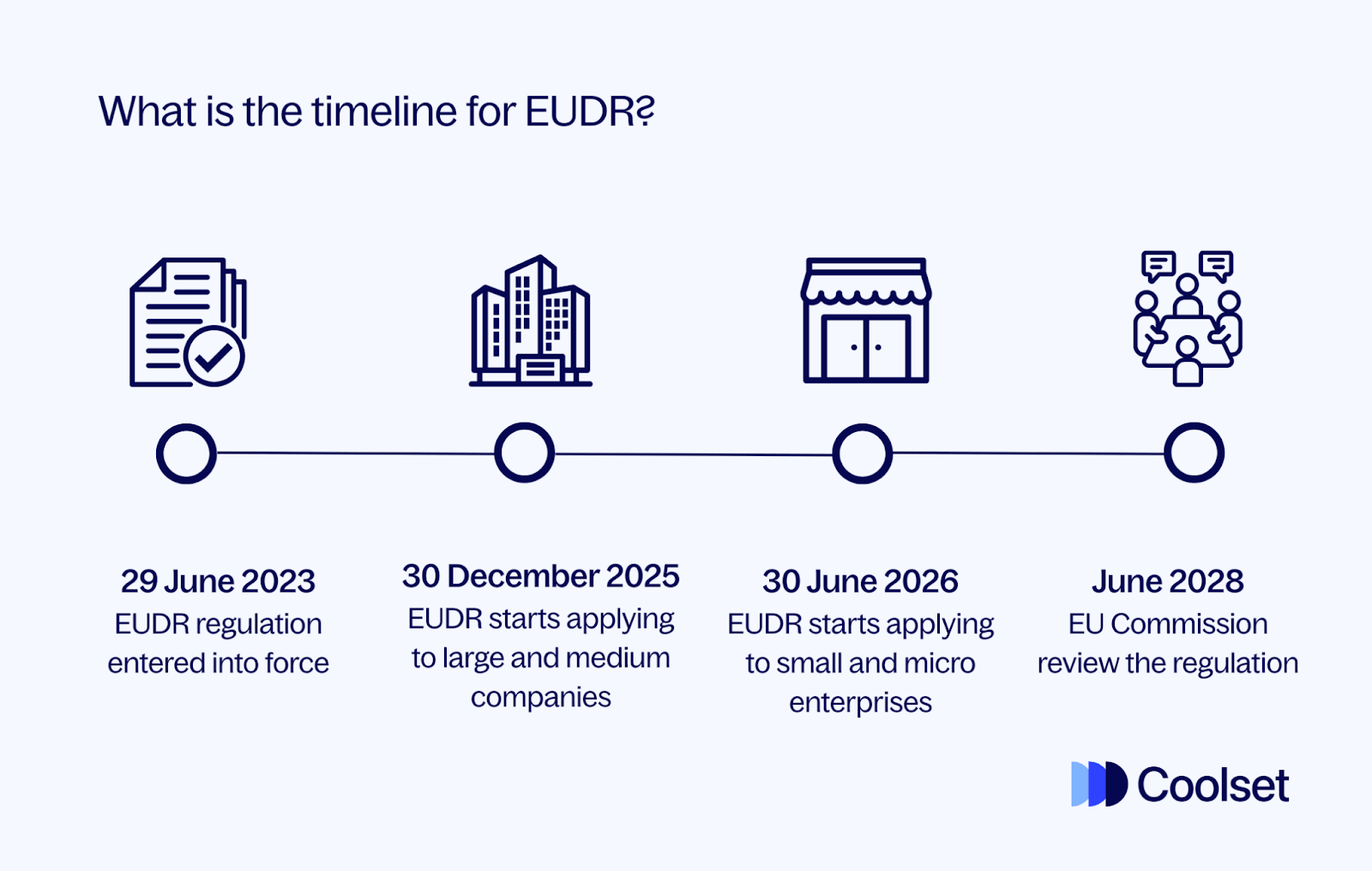
The EU Deforestation Regulation (EUDR) is on a fixed timeline – and failing to prepare in time can mean costly disruptions. Large and medium companies face a 30 December 2025 compliance deadline, while small and micro businesses have until 30 June 2026. These staggered dates give companies a transition period, but that time can slip away quickly.
Preparing in well-defined phases helps ensure nothing is left to the last minute. EUDR compliance cannot be completed in a single action; it requires integrating new workflows into your operations, contacting suppliers and collecting information. Failing to comply by the deadlines increases the risk of shipment blocks, fines, or scrambling to meet requirements under pressure.
The EU has already granted an extra 12-month phase-in as many firms weren’t ready by 2024, with the European Commission noting this additional time is a ‘valuable window’ to strengthen readiness. This article will help you do just that, guiding you through all stages of EUDR compliance, to ensure that you hit the ground running.
The key EUDR enforcement dates are as follows:

For large and medium-sized enterprises (those with a December deadline), the second half of 2025 is the make-or-break period to get EUDR compliance over the finish line. By Q3 2025, you should be deep into implementation. By Q4 2025, everything should be in place so you can “go live” by the December deadline. Here is an action plan for what do to in H2 2025:
If any supplier data is still missing, now is the time to fill the gaps. Reach out upstream - farmers, producers, traders - and clearly explain the data you need, such as GPS coordinates of farms, proof of land legality, and other origin information. The information you require will vary between suppliers, based upon their position in the supply chain and the country in which they operate in.
Many suppliers, especially in origin countries, might be unfamiliar with these requirements. Use this period to identify any unprepared suppliers and assist them (with templates, training, etc.). Early engagement is critical because suppliers vary in readiness; the sooner you spot issues, the more time you have to resolve them. For example, a coffee importer working with hundreds of smallholder farmers should start collecting farm GPS points and forest-cover evidence by Q3 2025 – this can easily take months of coordination in remote regions.
Make an exhaustive list of all commodities and products your company deals in, and check them against EUDR’s scope. The regulation covers not just raw materials but also many derived products (e.g. chocolate, leather goods, paper). For each in-scope item, determine its CN/HS code and verify it’s listed in EUDR’s Annex I. This exercise ensures no product line is overlooked.
If you haven’t done this by mid-2025, do it now – mapping your entire product catalog to the regulated list will clarify which supply chains need due diligence. (As a sector example, a leather goods manufacturer should confirm whether all types of leather and hides they use are listed under the cattle-derived products in Annex I. This influences which suppliers – e.g. tanneries or slaughterhouses – they must gather data from.)
By Q3 it is important to know how you will manage the data and workflow for EUDR compliance. Some companies build internal systems; others adopt third-party software. The key is to have a central repository for all required information (geolocation coordinates, supply chain documents, risk assessments) and a mechanism to generate the due diligence statements (DDS) for each shipment.
Ensure your solution can handle shipment-level data and keep an audit trail. If you’re still using spreadsheets at this stage, consider migrating to a more robust tool that supports EUDR’s detailed record-keeping and risk analysis needs. Remember, every batch will need a DDS, so your system should make it as streamlined as possible.
{{custom-cta}}
Q4 2025 is time to make sure all relevant staff know their roles in EUDR compliance. Procurement, sustainability, and logistics teams should understand how to collect data and when to trigger a DDS submission. It’s wise to practice creating and submitting a DDS ahead of the deadline. The European Commission’s EUDR online portal (built on the TRACES platform) offers a training environment where companies can register and simulate filing a due diligence statement. By practicing in the TRACES test system, your team can get comfortable with the interface and ensure you know what information is required for each submission.
Run an internal dry-run drill: for instance, take one high-risk supply chain and go through all steps – collect its data, perform a risk assessment, and generate a dummy DDS – as if you were shipping under EUDR already. This “pilot” will quickly highlight any bottlenecks or missing information while you still have a few months to fix them. It’s much better to discover in October 2025 that, say, your palm oil supplier can’t provide precise plot maps, than to discover it in January 2026 when your shipment is stuck at customs.
By late 2025, large/medium companies should have a clear process for evaluating deforestation risk in each supply chain. If any sourcing regions are identified as higher risk (e.g. commodities from areas with known forest clearance), have mitigation measures ready. This could include obtaining additional evidence from suppliers, conducting third-party audits, or even adjusting your sourcing if necessary.
The goal by Q4 is that for every in-scope product you will place on the market after Dec 30, 2025, you have documented proof it’s “negligible risk” (no recent deforestation or illegality) and can show how you reached that conclusion. Use the remaining time to close any gaps in evidence. For example, if a plantation’s satellite imagery is unclear, get updated imagery or on-the-ground verification now. By the deadline, you want zero guesswork about compliance for each product.
By following this Q3–Q4 2025 plan, large and medium enterprises can enter the enforcement date with confidence. In summary, don’t leave onboarding, system setup, or trial runs until the last minute. As one expert guide put it, waiting until just a few months before the deadline is too late - companies should use the transition period to “start mapping their supply network, collecting documents, and even run a dummy due diligence workflow” so that there’s no last-minute scramble

As 30 December 2025 looms, large and medium companies need to wrap up any loose ends and ensure they are truly audit-ready. Consider the weeks leading up to the deadline as a “freeze” period for your compliance project – everything should be tested and in place by then. Key tasks to complete before the EUDR goes live include:
The DDS is an official declaration attesting that due diligence was performed and the product is compliant. You don’t actually submit DDSs before the law applies, but you should be ready to generate one immediately for any shipment on Dec 30 or after. Some companies plan no imports in the final days of 2025 to avoid complications; others may try a voluntary test submission if the system allows. At minimum, have a filled-out DDS template for a representative shipment so you’re confident you can hit all the required fields under time pressure.
By early December 2025, your EUDR compliance process should be fully integrated into internal workflows. This means roles and responsibilities are assigned and documented; and everyone is trained on the process or software you are using to manage EUDR compliance.
The end of 2025 is also a good time to update any internal SOPs or checklists to align with EUDR. For example, your import department’s standard operating procedure should now include “Verify DDS reference is obtained before shipment release” as a mandatory step.
Treat the pre-deadline phase as a final internal audit of your due diligence system. Verify that all required Article 9 information (geolocation, legal documents, etc.) is collected for each relevant supplier, and the evidence is correct, accurate and easily accessible.
Simulate an authority audit by ensuring you can pull up any required record within a few hours if asked. A defensible compliance system depends not just on doing the work, but on organizing evidence so it can be presented clearly.
Going into 2026, there should be no pending questions about the compliance of products you will place on the market. If something cannot be fully resolved (say a supplier still hasn’t provided a needed document), make a business decision: either delay importing that product or source it elsewhere until you have certainty. It’s better to pause a shipment than to risk a violation.
Finally, loop in your downstream and upstream partners about the switch-on of EUDR. Inform your customs brokers or freight forwarders that, as of the end of 2025, every shipment will need a DDS reference number – they should be ready to include that in customs declarations.
Likewise, inform customers (especially if you are a B2B supplier) that you are EUDR compliant and what new documentation they might see. Clear communication ensures no surprises in the supply chain when the regulation takes effect.
Small and micro enterprises have a bit more breathing room – until 30 June 2026 – but they shouldn’t procrastinate. The extra six months exist because SMEs typically have fewer resources, not because their obligations disappear. In fact, medium-sized firms (≥50 employees/€10M turnover) are not considered “small” for this purpose and must already comply by Dec 2025. So the Jan–June 2026 window is mainly for truly small businesses.
Reaching the enforcement date is not the end of the journey – it’s the start of continuous compliance. After EUDR requirements kick in (Dec 2025 or June 2026, depending on company size), businesses need to incorporate due diligence into regular operations and keep it up-to-date. Here are the ongoing tasks and best practices after the law is in effect:
In essence, after the enforcement deadlines, companies enter a phase of continuous improvement and vigilance. Regular due diligence updates, periodic internal audits, and responsiveness to new risks or rules will characterize the compliance landscape. By doing so, you’ll not only meet your legal obligations but also build trust with customers and regulators that your supply chain remains clean over time.
Start preparing for EUDR immediately – the earlier, the better. Large and medium companies ideally should have begun in 2024 or early 2025 to meet the Dec 2025 deadline. If you haven’t, start now; don’t wait until a few months before the law applies. Small companies with a June 2026 deadline should use the extra time but still aim to have their systems in place well before that date. In short, give yourself at least 6–12 months of lead time for all the data gathering and process setup.
If you encounter a data gap (for instance, a supplier can’t provide a precise plot map) in your EUDR preparations, consider sending an independent verifier or using a service that can generate that data. EUDR products are built to support you meeting your data requirements.
In worst-case scenarios, if you truly cannot get sufficient data to assess a supply chain, you may need to halt sourcing from it until compliance can be confirmed. It’s better to have a temporary pause than to risk non-compliance due to missing information.
Supplier responsiveness in the EUDR compliance process is a real challenge – which is why engaging them early is so important. If a supplier is slow to respond, try breaking down requests into simpler tasks, or offer help. For example, if a farmer cooperative isn’t providing GPS coordinates, you might use an approximate location they gave and find the coordinates yourself, then ask them to confirm. Sometimes language or technology barriers are the issue – provide translated instructions if needed, or have a local agent assist.
In the extended run-up to the deadlines, some companies have even dropped high-risk, non-cooperative suppliers and onboarded new ones who can demonstrate traceability. Use carrots and sticks: let suppliers know compliance is a condition for doing business going forward (and after 2025/2026 it’s legally non-negotiable).
Yes. The European Commission has provided a training environment on the EUDR Information System (TRACES) where companies can log in and simulate the DDS submission process. It’s highly recommended to use this sandbox. You’ll learn what fields are required, how to attach supporting documents, and how to retrieve the DDS reference number.
EUDR compliance is ongoing and iterative, not a one-off task. After the deadline, you need to continuously ensure each new product or shipment is compliant – deforestation-free, legal, and backed by due diligence. Supply chains are dynamic, so you must monitor for changes (new sourcing areas, expansions into forest frontiers, etc.). At minimum, conduct a full review of your due diligence system annually as required by the regulation. In practice, many companies will do more frequent spot-checks – for example, a monthly review of a sample of DDS submissions for accuracy.
Use our hands-on guide to score country, supplier, and shipment risk under the EUDR.
.webp)
Updated on March 24, 2025 - This article reflects the latest EU Omnibus regulatory changes and is accurate as of March 24, 2025. Its content has been reviewed to provide the most up-to-date guidance on ESG reporting in Europe.
Updated on July 25, 2025 - This article references a previous version of the EUDR country risk benchmarking system. On July 9, the European Parliament rejected the proposed classification. We are actively monitoring the latest developments. For the most up-to-date guidance, read our updated article on the EUDR benchmarking vote. In the meantime, assume full due diligence applies across all regions.